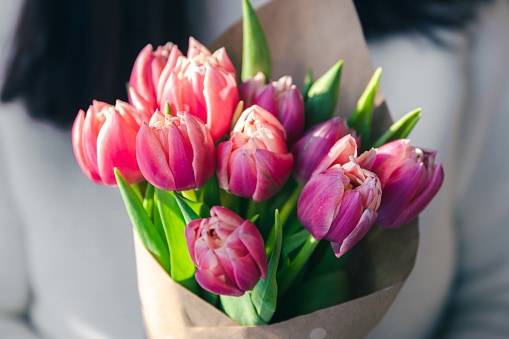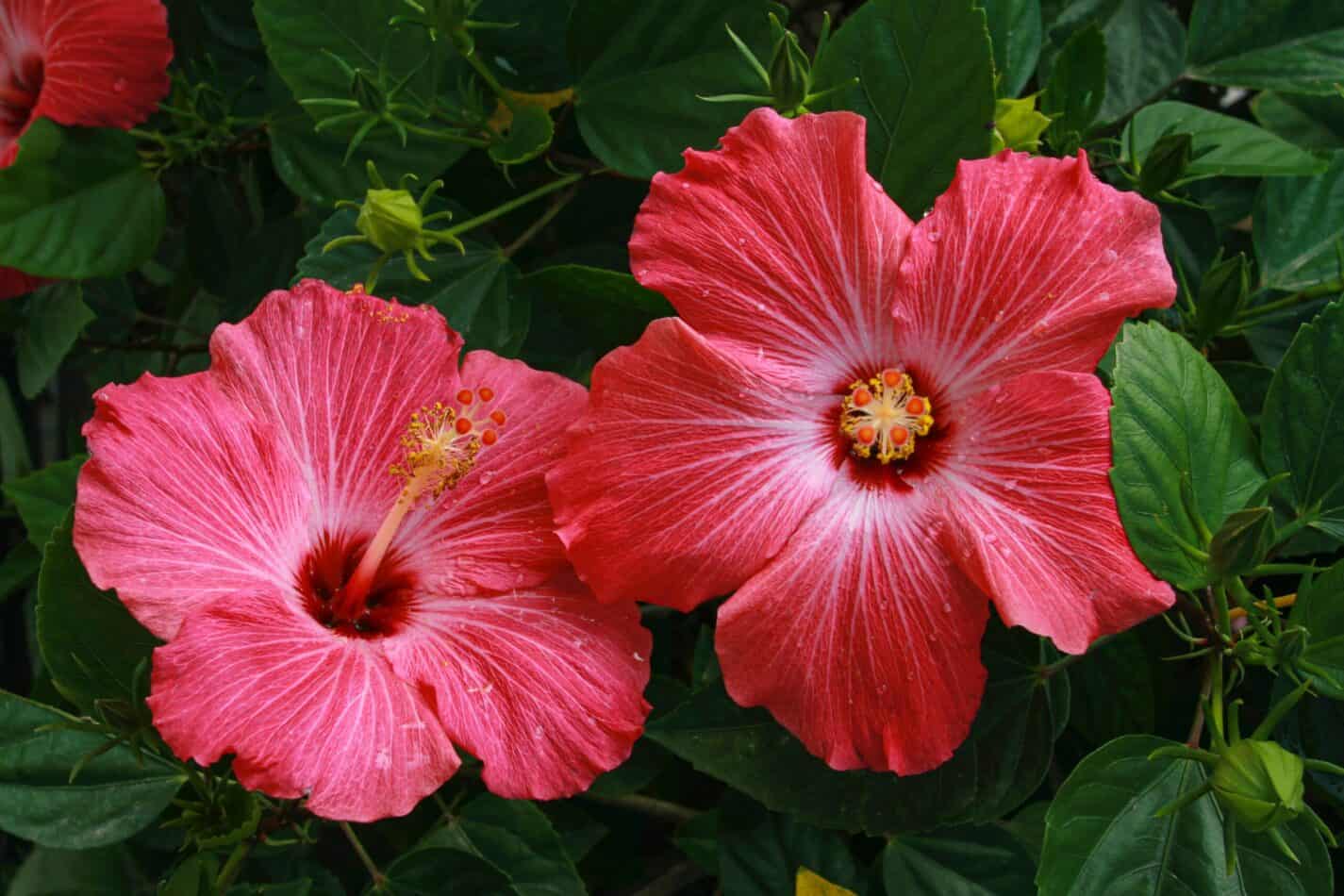Tulips are bulbous spring-flowering plants in the genus Tulipa, part of the family Liliaceae. One of the most popular bulbs for gardens, they come in an array of colors, sizes, and varieties. While they are typically planted as tender perennials and may decline in performance after several years, some species are hardy in the right climate.
Tulipa
Tulipa is a genus of flowering plants in the family Liliaceae comprised of around 150 species. They are herbaceous perennials that occur in an array of sizes, flower types and blooming times. The most popular of the Tulipa are grown as ornamental plants and are a symbol of spring. The flowers vary in size and complexity, but typically have single or double heads, frilled or straight edges, and a range of colors to choose from. In suitable climates, the bulbs can be grown for years, although their performance may decline over that time.
Family
Tulip and Tulipa are part of the family Liliaceae, which is the largest family in the order Liliales. The family Liliaceae is thought to contain between 600 and 650 species of flowering plants, which are mostly perennial herbs. It is found throughout the world, but is most diverse in temperate areas in the Northern Hemisphere.
Plant Type
Tulip and Tulipa are typically grown as tender perennials, although some species are hardy in the right climates.
Mature Size
When referring to plants, “mature size” usually refers to the ultimate size that a plant will reach when it has reached its full growth potential. In the case of tulips, the mature size can vary depending on the variety of tulip and the growing conditions.
As mentioned, tulips can reach heights between 6 and 24 inches, but this can vary depending on the type of tulip. Some tulips, like the Kaufmanniana or Greigii tulips, are known for their smaller size and may only reach a mature size of 6-8 inches in height. Other tulips, like the Darwin hybrid tulips, can reach a mature size of up to 28 inches in height.
In addition to height, mature size can also refer to the width of the plant and the size of its foliage. Tulips typically have narrow, lance-shaped leaves that grow from the base of the plant, and the mature size of the foliage can vary depending on the variety.
Factors that can affect the mature size of tulips include the growing conditions, such as soil quality, moisture levels, and sunlight exposure. In general, tulips will reach their full size after a few years of growth, and they may continue to bloom annually if they are well-maintained.
Sun Exposure
Sun exposure is an important factor to consider when planting tulips. Tulips are known for their showy, colorful blooms, and they require adequate sunlight in order to thrive and produce these blooms. In general, most tulips prefer full sun exposure, which means at least 6 hours of direct sunlight per day. However, there are some varieties of tulips that can tolerate partial shade and still produce blooms.
When planted in full sun, tulips will typically grow taller and produce larger blooms. They will also bloom earlier in the spring than tulips that are planted in partial shade. In contrast, tulips that are planted in partial shade may have shorter stems and smaller blooms, and they may also bloom later in the season.
It’s important to note that while some tulips can tolerate partial shade, they still require a minimum of 3-4 hours of direct sunlight per day in order to produce blooms. Tulips that are planted in areas with too much shade may become leggy, meaning that they will have longer, weaker stems and smaller blooms.
When planting tulips, it’s also important to consider the orientation of the planting site. Tulips that are planted in north-facing areas may receive less sunlight overall, while those planted in south-facing areas may receive more intense sunlight during the hottest part of the day. In general, a planting site that receives morning sun and afternoon shade can be a good option for tulips, as this provides them with adequate sunlight while protecting them from the hottest part of the day.
Soil Type
Tulip and Tulipa prefer well-draining, fertile soils with a neutral pH.
Soil pH
Most Tulip and Tulipa prefer a neutral soil pH, between 6.5 and 7.
Bloom Time
Tulip and Tulipa typically bloom in the spring, anywhere from late March to early May, depending on variety and climate.
Flower Color
Tulip and Tulipa come in a wide range of colors, from whites and pastels to vivid purples, reds and yellows.
Hardiness Zones
Most Tulip and Tulipa are hardy in Zones 3 to 8.
Native Area
Tulip and Tulipa are native to temperate regions of Europe, Asia and North Africa.
How to Plant
Tulip and Tulipa are generally easy to care for. They should be planted in a spot that receives full sun and has well-draining, fertile soil. If your soil is not ideal, try amending it with compost or other organic matter. Plant the bulbs in early fall, around 8 inches deep, with the pointed end facing up. Water the bulbs generously and avoid frequent watering once they have been planted and the soil has settled. In harsher climates, you may need to mulch your Tulip and Tulipa to protect them from the cold winter temperatures.
How to Plant and Grow
Tulip and Tulipa require some basic gardening care and conditions in order to thrive and flower. They need plenty of sunlight and well-draining soil that is amended with compost or other organic matter. They should be planted 8 to 10 inches deep in the fall, with the pointed end facing up, and should be watered generously after planting and then monitored for consistent moisture. Monthly fertilization is recommended to help the plants remain in optimal condition as well as keep pests away and prevent disease. In regions with cold winters, consider mulching your Tulip and Tulipa to protect them from the frost.
Meaning and Symbolism
Tulip and Tulipa are widely known for their beauty and vibrant colors, and have been associated with prosperity, wealth, and love. They are said to symbolize a fresh beginning and are often used as a symbol of gratitude and admiration. Throughout history, they have been used to express feelings of love and friendship and in recent years have become popular symbols of love. Tulip and Tulipa were even said to represent the resurrection of Jesus for early Christian churches.
History, Mythology, and Religious Significance
Tulip and Tulipa have a long, rich history, and have been admired and grown for centuries. Originally native to Asia Minor and the Middle East, they have a long association with Turkish sultans and the Ottoman Empire. They made their way to Europe in the 1500s, and by the 1600s they were extremely popular and coveted, leading to what became known as tulip mania in Holland. Ancient Egyptians and Romans wrote and spoke of the beauty and significance of Tulip and Tulipa, and the legendary Greek goddess Aphrodite was said to have given the flower its beautiful shape. In the Christian religion, they have been said to signify the resurrection of Jesus and new life in the world.
Flower Varieties and Their Defining Characteristics
The Tulip and Tulipa genus contains over 150 different species, with many more varieties and cultivars available. Some of the most popular varieties include:
- Single Late Tulips – Long stems and large flowers make single late tulips a crowd favorite. They bloom mid-April to early May and feature big colorful, cupped shaped flowers atop single stems.
- Fringed Tulips – These tulips feature edged petals and undulating florets on one inch long stems. They bloom in late April and May and come in a range of colors.
- Parrot Tulips – Also known as flaming tulips, parrot tulips have twisted, segmented petals. They are quite showy and bloom in both late April and May.
- Lily-Flowered Tulips – Lily-flowered tulips have delicate shapely petals and are most commonly grown in bouquets. They make a great border plant and bloom in late April and May.
- Double Late Tulips – Double late tulips are large flowered varieties with extra petals to create a full bloom. The large, star-shaped flowers are long lasting and bloom late April to May.
How to Pot and Repot
Tulip and Tulipa bulbs should be preserved to ensure the flowers bloom for many years come. The flowers can be potted in containers and can flourish indoors, or planted in a permanent spot outside in the garden. Choose a potting mix specifically designed for bulbs—either indoor or outdoor—and be sure to use a pot large enough to accommodate the roots without overcrowding or crowding the bulbs. The bulbs should be planted in the soil a couple of inches below the surface and should be watered right away. Water regularly and be sure to place the pot in a location that offers good drainage and adequate sunlight.
When it comes to repotting, you only need to do so if the bulbs become crowded in their containers. To repot, remove the bulbs and separate out any new bulbs that have already formed. Replant the bulbs in the new pot and be sure to water them with ample amounts of moisture. If repotting in the fall, wait until springtime to do so.
How to Prune
Tulip and Tulipa do not need to be pruned to maintain their health and size. For aesthetic purposes, however, it is a good idea to prune them after their leaves have dried and died back. Trim off the dead foliage at the base of the stem and discard. This will also help to reduce the spread of diseases and pests.
How to Propagate
Tulip and Tulipa are easily propagated through the division of the clumps. You can also divide the bulbs and replant them to increase their numbers. First, carefully lift up the bulb in its clump using a garden fork or spade. Try to keep as many of the roots and clumps intact as possible. Separate the bulbs, getting rid of any that are damaged or that have rotted. With the healthy bulbs, replant them in their new location, setting the bulbs so that their tops are just below the surface of the soil. Water them until the soil is moist and then provide ample amounts of sunlight, water, and fertilizer to get them off to a good start.
Common Pests and Diseases
Tulip and Tulipa are susceptible to a number of pests and diseases, many of which can be prevented before they start. To avoid disease, always purchase healthy bulbs and make sure to plant them in well-drained soil. Additionally, be sure to prune off the dead leaves and decaying plant material from around the plant. This will help to remove any pathogens and reduce the spread of pests or diseases. In order to avoid pests, use a fungicide and insecticide if necessary, as well as experiment with natural remedies like garlic or chili powder.
Frequently Asked Questions
Q: When Should I Plant Tulip and Tulipa Bulbs?
A: Tulip and Tulipa bulbs should be planted in early fall for best results. This will ensure that the bulbs have plenty of time to root before the frost of winter sets in.
Q: What Soil Should I Use To Plant Tulip and Tulipa Bulbs?
A: Tulip and Tulipa bulbs prefer well-draining, fertile soils with a neutral pH. Amend your soil with organic matter if needed, and avoid overly acidic or alkaline soils.
Q: What Climate Is Best For Growing Tulip and Tulipa?
A: Tulip and Tulipa enjoys mild climates and prefer cooler temperatures. They can be grown in colder climates but need to be mulched to protect them from frost.
What we love from Amazon this week
Buy these wonderful flowers directly from Amazon:















